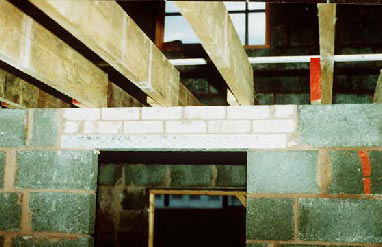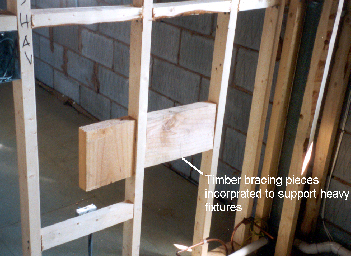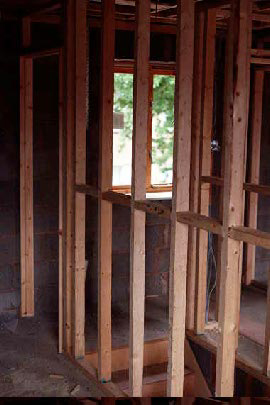Chapter 9 case study: Internal division of space: walls and partitions Formation of partitions: Masonry
The use of masonry partitions for the ground floor areas of dwellings is common. Their good loadbearing ability and the level durability are factors affecting choice. Here we see the timber joists of the upper floor supported on a ground floor internal wall. The wall is formed in concrete block with a simple lintel above the opening to a doorway. Note the use of concrete bricks to make up the gap above the lintel.
Formation of partitions: stud
The timber framing of the stud partition provides a base for the application of plasterboard cladding. For lightweight fixtures and fittings this provides sufficient strength in itself. Where heavier items are to be fixed, such as WC cisterns, a fixing rail must be provided as shown here. The deep timber section acts as a rigid support for the heavy fixing.
The horizontal bracing pieces seen here are termed ‘noggins’. They provide lateral rigidity to the partition and are generally positioned so that the horizontal joints in the plasterboard cladding can be fixed securely. Note also the base rail of the partition, which is fixed to the floor to provide a sound anchorage for the vertical studs.
Here we see the detail at a door opening. Note that the door lining is fixed prior to the studding being clad with plasterboard. This allows the plasterer to finish up to the edge of the lining to create a neat junction, which is then concealed with architrave. The boxes and cabling for electrical switches and sockets are also installed at this stage. This is termed the ‘first fix’ stage of installation. Where the cabling is surface fixed to the solid external wall it is protected by the application of a plastic or metal cover strip (seen white here).
Stud walls are clad using plasterboard prior to being skimmed with finishing plaster. Here we see the plasterboard panels fixed and awaiting finishing. The panels are supplied in sizes based on a 600 mm module. This dictates the spacing and positioning of studs and noggins, which must be placed so as to provide a base for fixing the boards.









